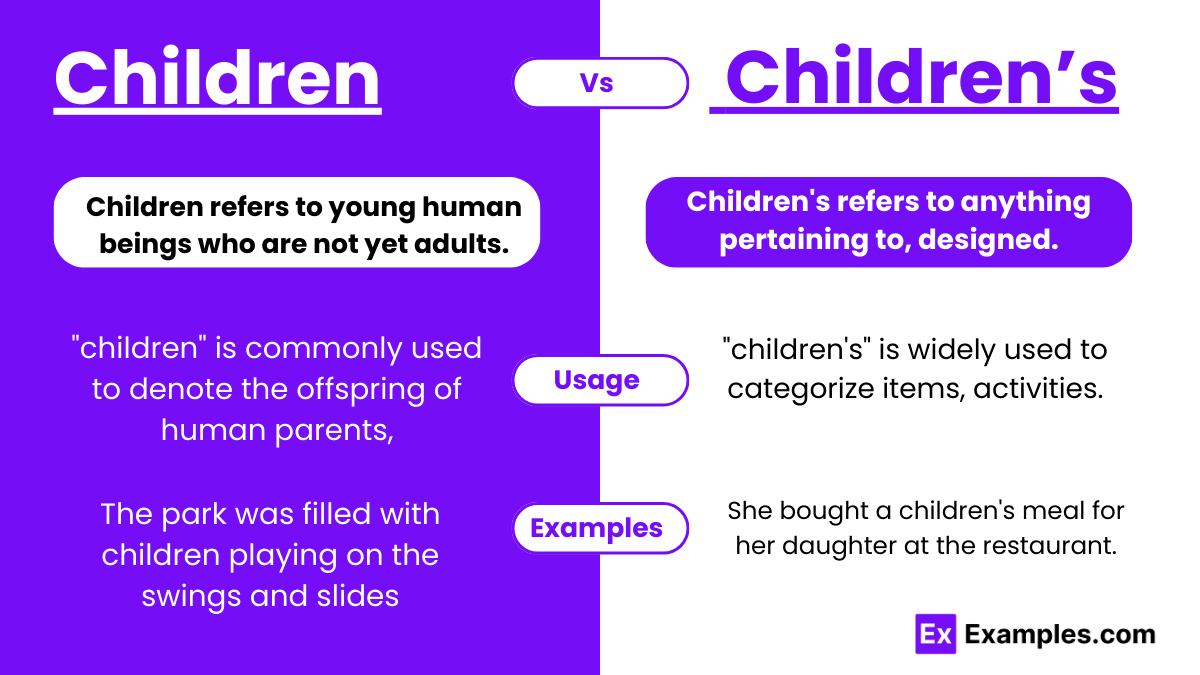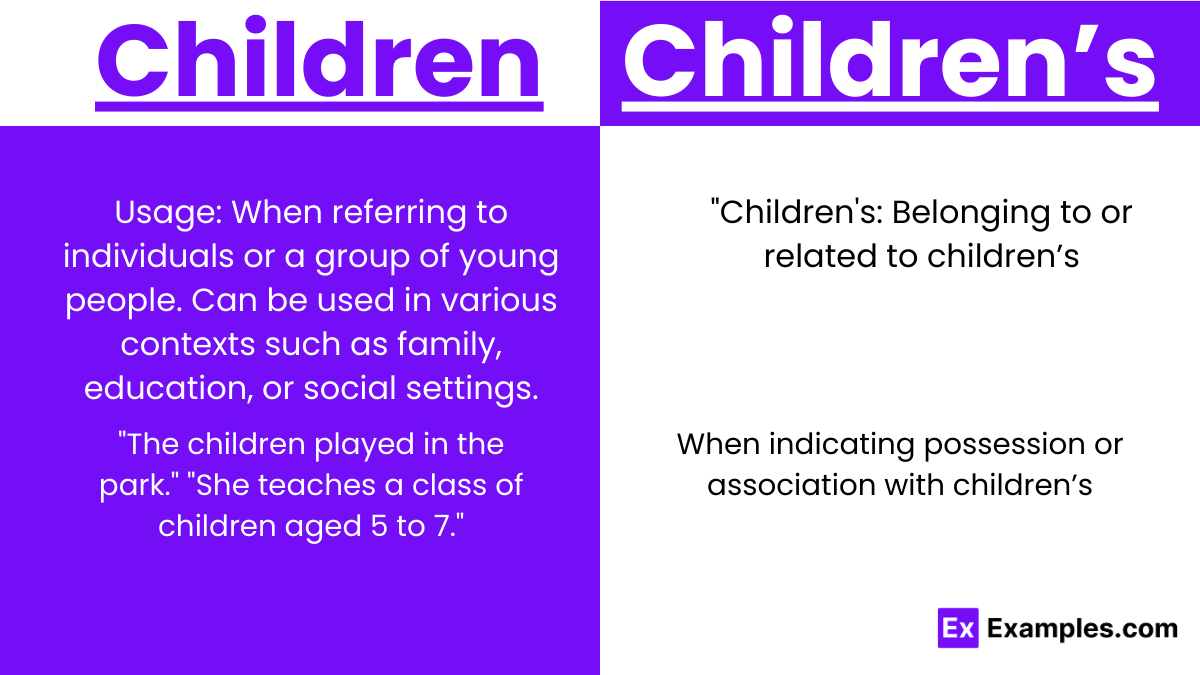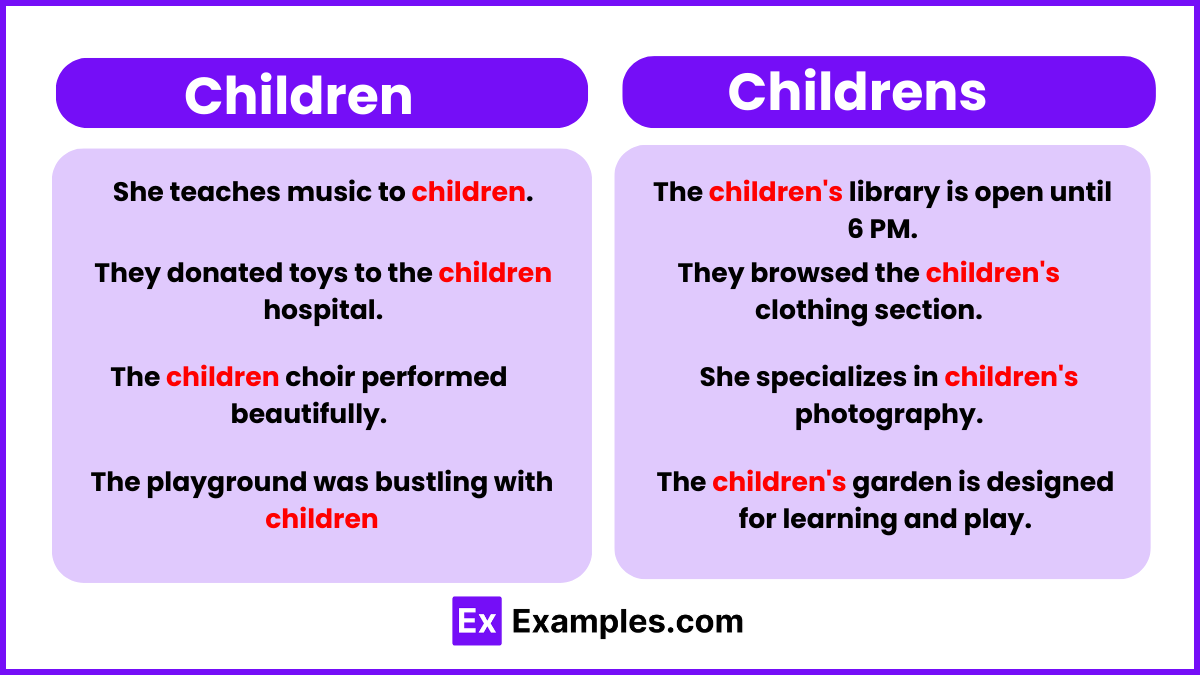Children vs Children’s
The distinction between “children” and “children’s” essentially comes down to the difference between a noun and its possessive form. “Children” is the plural form of “child,” referring to more than one young human being. It’s used when talking about kids in general or a specific group of kids without implying ownership or a particular characteristic attributed to them.
On the other hand, “children’s” is the possessive form of “children,” indicating that something belongs to or is related to children. This form is used to denote ownership, association, or a specific characteristic of something as it relates to children. For example, “children’s books” means books intended for or belonging to children.
Understanding when to use each form allows for clearer communication, especially in contexts involving family, education, or children’s products and services.
Children and Children’s – Meaning
- Children
- “Children” refers to the plural form of “child,” signifying more than one individual who is in the stages of development from infancy to puberty. It encompasses all young humans before they reach adolescence, highlighting their role, experiences, and characteristics pertinent to their age group. The term “children” is used to discuss this demographic collectively, whether in the context of family, education, societal roles, or development stages.
- Children’s
- “Children’s” is the possessive form of “children,” indicating ownership or association with children. It is used to signify that something belongs to, is designed for, or is intended for children. This can apply to a wide range of contexts, including children’s clothing, children’s books, children’s rights, and children’s toys, emphasizing that these objects or concepts are specifically meant for the young human demographic.
Summary
Understanding the distinction between “children” and “children‘s” is crucial for clear communication, especially in contexts involving youth. “Children” simply denotes the plural of “child,” encompassing all individuals in the age group before adolescence. This term is used when referring to this group in a general or collective sense. On the other hand, “children’s” is the possessive form, used to indicate that something is of, for, or related to children, be it in terms of ownership, design, or suitability. The difference between these two terms lies not just in grammatical structure but in the relationship between children and the subjects or objects being discussed. Whether it’s discussing children in a societal context or referring to items and concepts specifically designed for them, recognizing when to use each term enhances clarity and specificity in communication.
How To Pronounce Children and “Children’s
Children
- Phonetic Spelling: /ˈtʃɪl.drən/
- Pronunciation Tips: Begin with the “ch” sound as in “check,” followed by a short “i” sound like in “sit.” The “ldr” comes together as a single fluid sound, starting with “l,” then a soft “d” rolling immediately into an “r” sound. The word ends with the “ən” sound, which is like the “en” in “taken.”
Children’s
- Phonetic Spelling: /ˈtʃɪl.drənz/
- Pronunciation Tips: Start with the same “ch” sound as in “children,” followed by the short “i” sound. The “ldr” blend is identical to “children,” but this term ends with an “ənz” sound. The final “s” denotes the possessive form, making a slight “z” sound at the end, almost as if there’s an extra syllable.
Difference Between Children and Children’s
| Aspect | Children | Children’s |
|---|---|---|
| Meaning | Refers to the plural form of “child,” indicating more than one child. | The possessive form of “children,” indicating ownership, association, or design for children. |
| Usage | Used to talk about groups of young humans before they reach adolescence. | Used to specify that something belongs to, is designed for, or is intended for children. |
| Examples | – The park was filled with laughing children.<br>- Children need proper nutrition to grow. | – Children’s books are on the top shelf.<br>- The charity focuses on children’s rights. |
| Context | General discussions about young people, their activities, needs, or rights. | Specifically references objects, places, or concepts that are for, about, or belong to children. |
| Grammatical Role | Subject or object in a sentence. | Shows possession; used before nouns to denote something related to children. |
Tricks to Remember Children and “Children’s
For “Children”:
- Think of Multiples: The word “children” already implies more than one child. Picture a group of kids playing together to remind you that “children” refers to multiple young individuals.
- No Apostrophe Association: Remember that “children” has no apostrophe, which means it’s simply the plural form of “child” and indicates nothing about possession or ownership.
For “Children’s”:
- Possession is Key: The apostrophe and “s” in “children’s” signify possession. Think of a toy or book belonging to a child. Whenever you see the apostrophe, it means something belongs to the children.
- Visualize an Object: When trying to decide which form to use, visualize an object like a book. If you’re talking about a book owned by children or intended for them, “children’s” with the apostrophe is the correct choice, as in “children’s book.”
When to Use children and children’s
Use “Children” When:
- Referring to More Than One Child: Use “children” when talking about a group of kids. This term is the plural form of “child,” indicating multiple young individuals.Example: The park was filled with children playing.
- Discussing Aspects Relating to Kids in General: When your conversation or writing pertains to children as a collective demographic, without implying ownership or specific belonging.Example: Children need nutritious food to grow healthy.
Use “Children’s” When:
- Indicating Possession or Association: Use “children’s” when something belongs to, is designed for, or is specifically associated with children. This possessive form signifies that the subsequent noun has a particular relevance to or is intended for the use of children.Example: The library has a large children’s section.
- Referring to Products, Services, or Spaces for Children: When mentioning items, areas, or services specifically created for or dedicated to children, “children’s” is the correct choice.Example: She donates annually to the children’s hospital.
How to Use Children and Children’s
Navigating the correct use of “children” and “children’s” is essential for clear and accurate communication. Here’s a brief guide to help you use these terms correctly:
Using “Children”:
- Definition: “Children” is the plural form of “child,” referring to more than one young individual.
- Context: Use “children” when talking about multiple kids in a general or collective sense.
- Example: “The school organized a field trip for all the children.”
Using “Children’s”:
- Definition: “Children’s” is the possessive form of “children,” indicating something that belongs to, is intended for, or is associated with children.
- Context: Use “children’s” before nouns to describe things like areas, products, or literature specifically designed for or related to children.
- Example: “I bought a book from the children’s section.”
Examples of Children and Children’s
Synonyms For Children and Children’s
| Term | Synonyms for “Children” | Synonyms for “Children’s” |
|---|---|---|
| General | kids, youngsters, minors, juveniles, youth | kids’, youngsters’, minors’, juveniles’, youth’s |
| Formal | offspring, progeny, descendants, heirs, wards | offspring’s, progeny’s, descendants’, heirs’, wards’ |
| Informal | tots, kiddos, little ones, tykes, rugrats | tots’, kiddos’, little ones’, tykes’, rugrats’ |
| Educational | students, pupils, learners, schoolchildren, class | students’, pupils’, learners’, schoolchildren’s, class’ |
| Medical | pediatric patients, neonates, infants, toddlers, adolescents | pediatric patients’, neonates’, infants’, toddlers’, adolescents’ |
Exercise
Fill in the blank with the correct form of Children and Children’s
- The playground is designed specifically for ________ safety.
- All the ________ at the party enjoyed the magic show.
- The new policy aims to improve ________ health care services.
- Many ________ in the neighborhood ride their bikes to school.
- The museum offers interactive exhibits in the ________ section
Answers
- children’s
- children
- children’s
- children
- children’s
FAQs
Is children’s a singular or plural?
“Children” is the plural form of “child.” The word “children’s” is a plural possessive form, indicating something belongs to multiple children.
Why do we say children’s day?
We say “Children’s Day” to denote a day dedicated to all children, using the plural possessive form to indicate the day belongs to children collectively.
How do you wish for Children’s day?
To wish for Children’s Day, you could say, “Happy Children’s Day to all the wonderful kids out there! May your day be filled with joy and laughter.”




